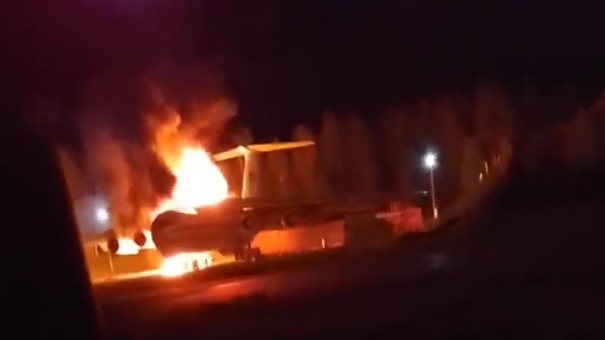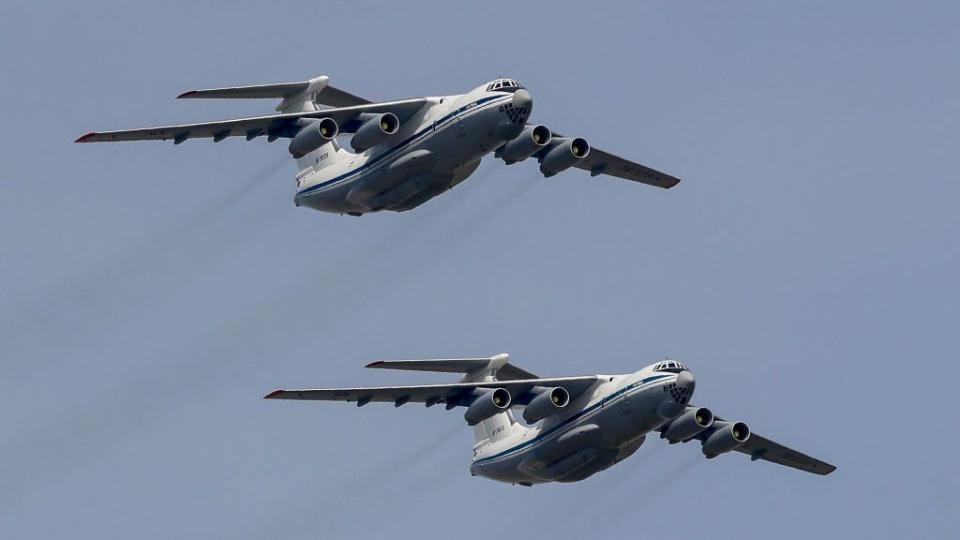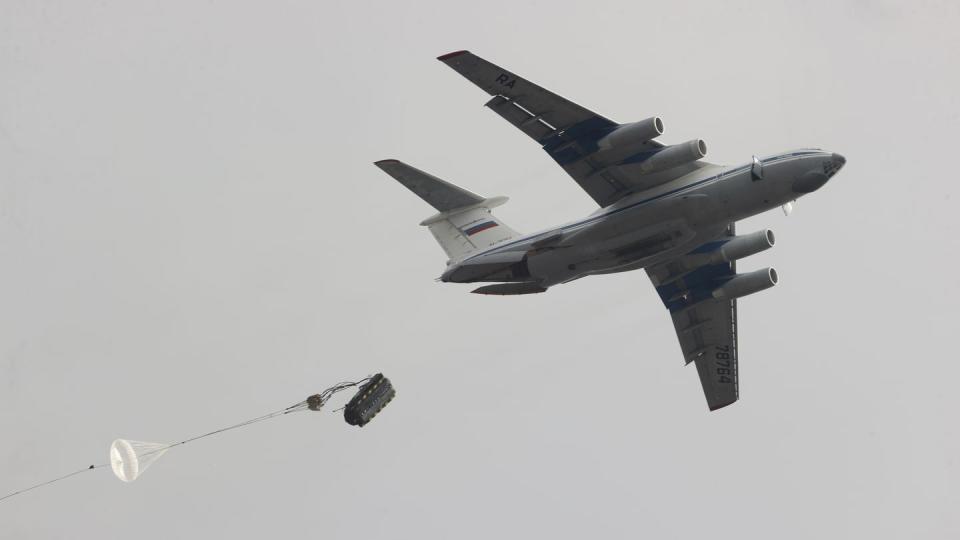4 Giant Russian Cargo Jets Just Went Up in Flames 400 Miles From Ukraine

Residents of Pskov, Russia must have thought they’d been transported abruptly into a World War II movie when, at 11:30 p.m. on August 29, their evening was disturbed by the buzz of small aircraft, the sporadic chatter of anti-aircraft guns, the thump of distant explosions, and an ominous orange glow emanating from nearby Kresty airbase, also known as Princess Olga Pskov International Airport.
Il-76 aircraft in Pskov airport, home to the 12th Military Transport Aircraft Division, as seen on the @planet satellite image, captured on August, 16th. pic.twitter.com/Fqe4j7uNB0
— Mark Krutov (@kromark) August 29, 2023
Before long, a towering column of smoke rose from the airbase used by Russia’s elite 76th Guards Airborne Division and the 334th Military Transport Aviation regiment. Ordinarily, the roughly 20 Il-76 strategic transport planes of the 334th would be at hand to rapidly transport the paratroopers 76th in response to a military crisis—now a moot point as the unit is currently in the thick of fighting in Ukraine.
Pskov airbase in northwest Russia was reportedly hit by a Ukrainian drone attack this evening.
Multiple large fires with possible secondary explosions visible. pic.twitter.com/lJs0cV4HOk— OSINTtechnical (@Osinttechnical) August 29, 2023
But that evening crisis came to Pskov. Subsequent reports claimed up to 22 Ukrainian drones had descended upon the airbase and “damaged”—in the words of Russia’s defense ministry—four large Il-76 strategic transport planes, of which two caught fire, as well as exploding aviation fuel storage tanks. No personnel casualties were reported, however.
Russian state media has occasionally described as “damaged” aircraft later photographed to be utterly consumed in flames—which to be the case again at Kresty, based on footage posted to social media.
Last night, the Kresty AB in Pskov Oblast, #Russia, home to the 334th Military Transport Aviation Regiment, was hit by a Ukrainian suicide drone attack.
According to Russian sources, 4 Il-76 heavy cargo aircraft were "damaged"- one can be seen burning fiercely in this footage. pic.twitter.com/iNRo9xgtNq— 🇺🇦 Ukraine Weapons Tracker (@UAWeapons) August 30, 2023
A spokesperson for Ukraine’s GUR intelligence agency—likely responsible for the attack—claimed to Reuters that four Il-76s were “destroyed” or left in a condition “beyond repair,” with “several other aircraft” damaged.
Some rumors circulating on Russian social media claim a total of six aircraft, including a Tu-22M supersonic bomber were damaged, though that claim may be lumping in losses from an earlier drone attack on August 19 that destroyed one or possibly two Tu-22Ms on August 19.
However, on Wednesday, new satellite photos analyzed by RFE's Schemes investigation team showed damage to the upper fuselage near the wings of two Il-76s at Pskov. An aviation expert RFE consulted suggested these reflected unsuccessful attempts to combust the aviation fuel stored there, but would still require an overhaul lasting at least two to three months. However, cloud cover prevented RFE from seeing the entire airfield to get visibility on all affected aircraft.
Another damaged IL-76 aircraft has same black spot. Two firetrucks can also be seen near it pic.twitter.com/P7zaul5J7O
— Kyrylo Ovsianyi (@KOvsianyi) August 30, 2023
Thus, photos and video appear to show two Il-76s were moderately damaged, one filmed consumed by fire was likely destroyed, and the condition of the fourth (and potential others) remains unclear.
On the same evening, Russian sources reported simultaneous drone attacks took place near Moscow, Kaluga, Oryol, Ryazan, Sevastopol and Bryansk, where drones damaged the Silicon-EL microelectronics factory that produces parts for Iskander tactical ballistic missiles and Pantsir short-range air defense systems—a system ironically tasked with defending against drones.
Explosions in Pskov (videos 1 and 2) and Bryansk (3) and Orel Oblasts (4), Russia, with reports of unidentified UAV sightings in other regions. This appears to be a well-orchestrated drone raid on Russia.
In Pskov, four IL-76 planes were reportedly hit in an airfield. All… pic.twitter.com/eVdegSkmNn— Dmitri (@wartranslated) August 29, 2023
Pskov is over 400 miles north of Ukraine, but less than an hour’s drive from the borders of Estonia and Latvia, a fact that led conspiracy mongers to claim the drones had originated from the former. Arch Russian state TV propagandist Vladimir Soloviev proposed with characteristic proportionality, “If true, than [sic] Estonia must be wiped off the face of the Earth!”
Vladimir Solovyov wonders whether the drones that hit a Russian military airfield in Pskov last night were launched from nearby Estonia
"If it's true then Estonia must be wiped off the face of the earth!" https://t.co/M8TNUBaEll— Francis Scarr (@francis_scarr) August 30, 2023
But base personnel and TV bloviators alike should already have been well aware of the threat of a non-Baltic-origin raid on places like Pskov after the August 19 attack on Soltsy-2 airbase used by Tu-22M bombers 75 miles to the northeast.
Rather than using long-range drones based in Ukraine, the Soltsy raid reportedly involved small civilian-style quadcopters likely released by infiltrated agents not far away from the targeted base. Afterward, the powerful strategic bombers abandoned that base in favor of one hundreds of miles more distant from Ukraine.
Few details have emerged regarding the type of drones used in Kresty airbase attack, but it seems likely a similar method was used.
While cargo jets are not as attractive a target as bombers, perhaps the transparent vulnerability of the many large aircraft based there made it to tempting a target to pass up. Moreover, Kyiv likely intended to send a message to the Pskov-based 76thAirborne Division, which was recently committed to high-intensity combat opposing Ukraine's counteroffensive near Robotyne.
The Il-76 and Russia’s Invasion of Ukraine
The Il-76 transport jet debuted in 1976, rapidly giving the Soviet Union a greatly expanded capacity to deploy large cargos or airborne units over longer distances. Powered by four D-30 turbofans, the Il-76 could carry 140 passengers or three BMD-series parachutable armored fighting vehicles, or 41 tons of cargo. And when carrying a medium-weight load, it could travel out to 2,700 miles. The Soviet Il-76 fleet was extensively utilized in the Soviet war in Afghanistan, where only two were lost to enemy fire despite coming under frequent attack.
Russia’s fleet of the latest Il-76MD-90As (also called Il-476s) can cram in up to 225 passengers using an optional double deck arrangement, and boast more powerful, fuel-efficient, and quieter PS-90A turbofans, allowing the aircraft to meet international standards. These have been delivered both to the 334th regiment at Pskov, and the 235th at Ulyanovsk.

The air transport capabilities Russia’s fleet of Il-76 strategic cargo planes surely aid the logistics of Russia’s war effort in Ukraine, but are not critical given availability of road networks and railway lines.
The reality was different early in the war. In the days immediately prior to Russia’s invasion on February 23, 2022, Il-76s ferried tens of thousands of soldiers from central and eastern Russia to the border with Ukraine, where vehicles and equipment awaited them, having already been transported by rail in preceding weeks.
On the war’s first day, Il-76s were loaded with paratroopers on standby, ready to land at Hostomel airport next to Kyiv after it was secured by an initial helicopter-borne attack. However, a stout initial Ukrainian defense; rapid counter attacks; and cratering of Hostomel’s runway by Ukrainian jets, artillery, and combat engineers made that impossible, fatally sabotaging Russia ‘checkmate’ strategy aimed at rapidly project troops into Kyiv.
One the evening of that first day, reports from Ukrainian forces and U.S. intelligence claim that Russian Il-76s attempted to parachute troops to capture Vasylkiv airbase south of Kyiv in coordination with an attack by infiltrated agents on the ground, and that Ukrainian Su-27 fighters and missile batteries downed two Il-76s full of paratroopers. However, no wreckage was ever found supporting this claim.
There is now little prospect of future Russian parachute or air-landing operations due to the present strength of Ukraine’s air defense network and vulnerability of transport aircraft like the Il-76.
Russia’s Il-76 fleet is essential, however, for maintaining communications with outposts and allies in the Middle East—namely Syria and Iran. That may include air-transporting Iranian kits from which to assemble Shahed kamikaze drones in a Russian factory staffed by high-school-age forced laborers, as well as logistically sustaining the substantial assets at the Russian naval base in Tartus, Syria.
Flight Global’s World Air Forces 2023 estimates Russia began 2023 with 119 Il-76s, though likely not all are immediately operational. Around 20 more Il-76MD-90As are believed to be on order, but they are expensive by Russian standards ($51 million each or more) and production at Ulyanovsk is slow and behind schedule. One newly built MD-90A suffered a deadly explosion in March 2023 during factory tests of its cargo hold pressurization system. There are, however, many Il-76s used by Russian civilian airlines that could be chartered or commandeered by Russia’s military.
Overall, damaging or destroying 3.5 percent of the Russian military's Il-76 fleet at Pskov will sting and strain logistics, but there’s likely enough redundancy for Russia to cope.
Why Russia’s 76th Guards Airborne Division Is in Ukraine’s Crosshairs
Pskov's status as homebase for the 76th Guards Airborne, which military analyst Rob Lee characterized as "arguably Russia's best division," likely played a role in its targeting.
Russia’s blue-bereted paratrooper and helicopter air assault troops are grouped in a separate branch from the Russian Ground Forces called the VDV. Since the Soviet war in Afghanistan, Moscow has relied disproportionately on the VDV to aggressively assault enemy forces in close combat instead of less well trained and more artillery-reliant regular mechanized forces.
Unlike Western-style airborne forces, VDV parachute units are mechanized, equipped with lightweight but heavily armed BMD and BTR-D fighting vehicles that can be parachuted or more easily air transported.

In 2022, the 76th’s three frontline regiments were deployed (and mauled) in nearly every battlefront across Ukraine, fighting at the forefront of the battles of Kyiv, Izium, Popasna, Kherson, and Bakhmut. The division’s 234th Air Assault Regiment was particularly identified by investigators as the perpetrators of atrocities—the torture and murder of civilians—in the Kyiv suburb of Bucha.
By the summer of 2023, the division had been partially rebuilt and rested, and was regarded was a ‘strategic reserve’—a sort of fire brigade on standby to hose down any point on frontline where the heat became too intense for local forces. It was partially deployed around Kreminna, a sector that Russian forces have held since Ukrainian advances last fall. As airborne capability became irrelevant, the unit has increasingly incorporated heavy T-72 and T-90 main battle tanks and BMP-2 fighting vehicles to replace losses of its thinly armored BMDs.
By around August 24 to 25, it became clear that elements of the 76th had been redeployed 150 miles southwest to oppose Ukraine's counteroffensive near Robotyne in Zaporizhizhya oblast. What this bodes can be interpreted in various ways.
On the one hand, some argue its commitment shows Russia’s military is no longer confident the local reserves in Zaporizhizhya suffice to absorb Ukraine’s counter offensive. While Russia can reshuffle other units, the 76th was the freshest and most well regarded. Many of the VDV’s other units have been sucked into containing Ukrainian forces advancing on the flanks of Bakhmut.
So while the 76th poses a significant threat to Ukraine's push in the south, if the 76th gets badly damaged, Russia's position might be in trouble.
The flipside, however, is that Russian leaders may have felt comfortable committing the 76th because Kyiv is believed to have committed the last of its carefully husbanded offensive brigades in August to its drive in Zaporizhzhya. Perhaps, then, Russian strategists believe Ukraine has no more brigade-sized ‘surprises’ awaiting play, and feel they can safely deploy their best division to directly counter Ukraine’s most threatening concentration of forces.
The Pskov-based paratroopers of the 76th division have been active on Ukrainian soil since 2014, when several of their personnel and vehicles were captured. Nine years later this August, Ukraine reached all the way back to the 76th’s home base—a shocking incident that may compel further spreading out of Russian air defenses to bases prior thought unlikely to come under attack.
You Might Also Like

